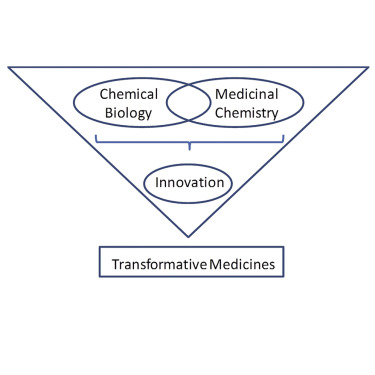当前位置:
X-MOL 学术
›
Cell Chem. Bio.
›
论文详情
Our official English website, www.x-mol.net, welcomes your
feedback! (Note: you will need to create a separate account there.)
Joining Forces: The Chemical Biology–Medicinal Chemistry Continuum
Cell Chemical Biology ( IF 6.6 ) Pub Date : 2017-06-08 , DOI: 10.1016/j.chembiol.2017.05.019 Alleyn T. Plowright , Christian Ottmann , Michelle Arkin , Yves P. Auberson , Henk Timmerman , Herbert Waldmann
Cell Chemical Biology ( IF 6.6 ) Pub Date : 2017-06-08 , DOI: 10.1016/j.chembiol.2017.05.019 Alleyn T. Plowright , Christian Ottmann , Michelle Arkin , Yves P. Auberson , Henk Timmerman , Herbert Waldmann

|
The scientific advances being made across all disciplines are creating ever-increasing opportunities to enhance our knowledge of biological systems and how they relate to human disease. One of the central driving forces in discovering new medicines is medicinal chemistry, where the design and synthesis of novel compounds has led to multiple drugs. Chemical biology, sitting at the interface of many disciplines, has now emerged as a major contributor to the understanding of biological systems and is becoming an integral part of drug discovery. Bringing chemistry and biology much closer and blurring the boundaries between disciplines is creating new opportunities to probe and understand biology; both disciplines play key roles and need to join forces and work together effectively to synergize their impact. The power of chemical biology will then reach its full potential and drive innovation, leading to the discovery of transformative medicines to treat patients. Advances in cancer biology and drug discovery highlight this potential.
中文翻译:

联合力量:化学生物学-药物化学连续体
所有学科的科学进步正在创造不断增加的机会,以增强我们对生物系统及其与人类疾病的关系的认识。药物化学是发现新药的主要驱动力之一,新化合物的设计和合成导致了多种药物的产生。化学生物学位于许多学科的交界处,现在已成为对生物学系统理解的主要贡献者,并已成为药物发现的组成部分。化学和生物学之间的距离越来越近,学科之间的界限越来越模糊,这为探索和理解生物学创造了新的机会。这两个学科都发挥着关键作用,需要共同努力并有效地协同工作,以发挥各自的作用。然后,化学生物学的力量将发挥其全部潜能并推动创新,从而导致发现可用于治疗患者的转化药物。癌症生物学和药物发现方面的进展突显了这一潜力。
更新日期:2017-07-22
中文翻译:

联合力量:化学生物学-药物化学连续体
所有学科的科学进步正在创造不断增加的机会,以增强我们对生物系统及其与人类疾病的关系的认识。药物化学是发现新药的主要驱动力之一,新化合物的设计和合成导致了多种药物的产生。化学生物学位于许多学科的交界处,现在已成为对生物学系统理解的主要贡献者,并已成为药物发现的组成部分。化学和生物学之间的距离越来越近,学科之间的界限越来越模糊,这为探索和理解生物学创造了新的机会。这两个学科都发挥着关键作用,需要共同努力并有效地协同工作,以发挥各自的作用。然后,化学生物学的力量将发挥其全部潜能并推动创新,从而导致发现可用于治疗患者的转化药物。癌症生物学和药物发现方面的进展突显了这一潜力。











































 京公网安备 11010802027423号
京公网安备 11010802027423号